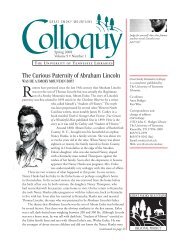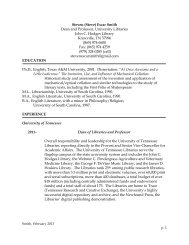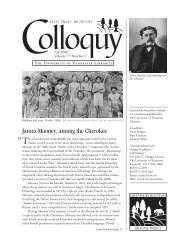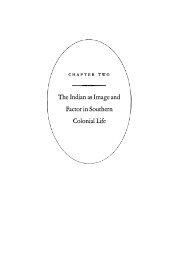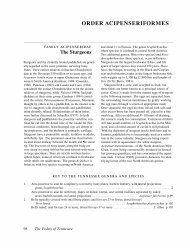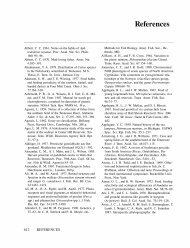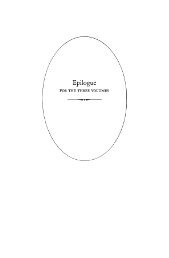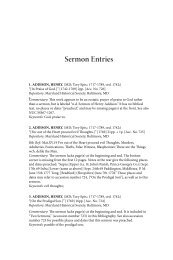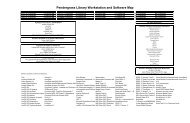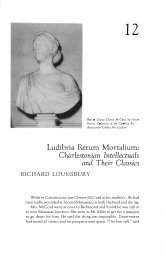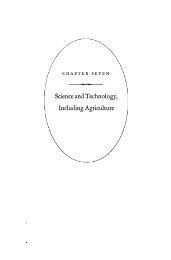Literature, Principally Belletristic - University of Tennessee, Knoxville
Literature, Principally Belletristic - University of Tennessee, Knoxville
Literature, Principally Belletristic - University of Tennessee, Knoxville
Create successful ePaper yourself
Turn your PDF publications into a flip-book with our unique Google optimized e-Paper software.
· <strong>Literature</strong>, <strong>Principally</strong> <strong>Belletristic</strong> .<br />
by an unpopular governor who had been bitingly attacked in a series <strong>of</strong><br />
manuscript Hudibrastic verses and dialect burlesque epistles which may<br />
have been written by a group <strong>of</strong> men largely for their own amusement.<br />
The tracts-for-the-times <strong>of</strong> the 1750S and 1760s composed throughout<br />
the colonies but at their artistic and critical best in the Chesapeake area,<br />
though <strong>of</strong>ten published in both colonial capitals and London and Edinburgh,<br />
were usually aimed at American readers.<br />
The southern sermons already considered which will soon appear in<br />
print or reprint, one hopes, in considerable numbers, from Hawte Wyatt<br />
and Deuel Pead and other preachers <strong>of</strong> early Jamestown to the betterknown<br />
pulpit orators <strong>of</strong> eighteenth-century Annapolis and Williamsburg<br />
and Charleston, were directed at local parochial congregations. Yet several<br />
dozen preachers survive in print and at least two in multivolumed collections<br />
in more than one edition. Of the last, James Blair avowed that he<br />
addressed his local congregation, and the reader <strong>of</strong> his down-to-earth Anglican<br />
homilies will agree that they seem peculiarily suited to the mixed society<br />
<strong>of</strong> the colony which listened to them, though at the same time one recalls<br />
that they were apparently widely read in Britain. The sermons <strong>of</strong> Samuel<br />
Davies, the other frequently published preacher, despite their appeal over<br />
a full century on both sides <strong>of</strong> the Atlantic, were clearly addressed to<br />
Virginia Presbyterians or to the colony's unchurched. They are as American<br />
as the Puritan sermons <strong>of</strong> Jonathan Edwards, and perhaps more American<br />
than the earlier preaching <strong>of</strong> Samuel Shepard and Edward Taylor.<br />
Neither Blair nor Davies nor their contemporaries Thomas Cradock and<br />
Samuel Quincy use the baroque imagery <strong>of</strong> the earlier New Englanders, but<br />
their romantic or pre-Romantic and sublime imagery compares with that <strong>of</strong><br />
their ablest New England contemporaries and springs perhaps from similar<br />
sources. And the rolling cadences, the alliteration, the antitheses <strong>of</strong> Davies'<br />
pulpit oratory are at once part <strong>of</strong> his age and the Great Awakening and <strong>of</strong><br />
the mind and spirit <strong>of</strong> this native-born American himself. Into the southern<br />
sermon have gone the flowers <strong>of</strong> rhetoric, the language <strong>of</strong> poetry, and in<br />
the instance <strong>of</strong> Davies as <strong>of</strong> Edward Taylor, verse itself. In a sense Taylor's<br />
verse is sui generis, but Davies' springs straight from the soil <strong>of</strong> the Great<br />
Awakening as that movement manifested itself in the South. It is a part<br />
<strong>of</strong> colonial homiletic writing and <strong>of</strong> a body <strong>of</strong> religious poetry which was<br />
itself a part <strong>of</strong> southern belles lettres.<br />
The largest body <strong>of</strong> southern prose, the <strong>of</strong>ficial legislative and executive<br />
and judicial, is <strong>of</strong> course purposeful. But as already noted, governors' addresses<br />
to Indian chiefs at treaty times are, at least as they are recorded,<br />
conscious art influenced by aboriginal forms and images in oral discourse.<br />
The charges to juries <strong>of</strong> governors or chief justices were at times philosophical<br />
essays, and the epistolary reports <strong>of</strong> <strong>of</strong>ficers <strong>of</strong> the Crown to the<br />
13 11



